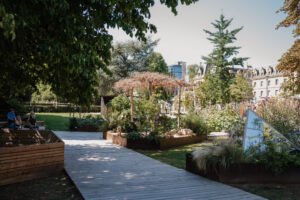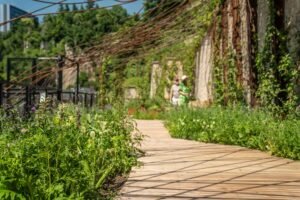In every garden, there is a story that begins long before the first plant takes root. The Luxembourg Urban Garden (LUGA) is no exception. What visitors have now experienced over last months as a seamless part of the city is the result of more than a decade of planning, coordination and collaboration.
In our previous blog post, “LUGA: Let’s go for a walk!”, we explored how the Luxembourg Urban Garden transforms parts of the city into living exhibitions – from raised beds of beans and onions to large-scale installations along the Alzette. This second article looks behind the scenes. It tells the story of how LUGA came to life: how a horticultural idea turned into a national open-air exhibition linking nature, culture and urban development.
Origins
The origins of LUGA go back to 2011, when Luxembourg’s horticultural association first proposed organising a national horticultural exhibition. At the time, the aim was to highlight the country’s strong horticultural and agricultural traditions, raise awareness of horticultural professions and strengthen public appreciation for local food production.

Gardens by the Luxembourg Horticultural Federation (source: Marion Dessard)
As described in an earlier CIPU article from 2021, this idea led to a series of feasibility studies and concept developments. Supported by the Ministry of Agriculture, Viticulture and Rural Development and the City of Luxembourg, the concept evolved from a classic garden show into a broader, more urban exhibition. The ambition was to showcase how sustainability and biodiversity could become part of everyday life in cities – a theme that would later shape the LUGA’s entire concept.
From vision to reality
To turn the idea into practice, the non-profit association LUGA asbl was established in 2019. Its founding members – the Ministry of Agriculture, Viticulture and Rural Development, the City of Luxembourg, the City of Ettelbrück and the Luxembourg Horticultural Federation – each hold equal shares. Other ministries, including Culture, Economy and Finance, joined as partners to support the cross-sectoral approach.
Originally planned for 2023, the exhibition was postponed to 2025 due to the pandemic and related material shortages. The delay allowed the organisers to refine the concept, expand the number of projects and strengthen cooperation with local and regional actors. With a total budget of around 22 million euros, co-financed equally by the state and the City of Luxembourg, the exhibition became a true national collaboration.
Designing an exhibition for the city
From the beginning, LUGA aimed to go far beyond traditional horticulture. Its motto, “Making the Invisible Visible”, reflects a broader view of the city as a living ecosystem – a place where water, food, biodiversity and culture are interconnected.
Racines du Futur (source: LUGA)
Fifteen thematic areas guided the exhibition, ranging from the environment and agriculture to social inclusion and technological innovation. Open calls and competitions invited young designers, artists and landscape architects from Luxembourg and abroad to contribute ideas. In parallel, workshops with citizens, schools and associations helped to shape specific projects and themes.
Coordination and challenges
Behind the many gardens and installations lies a small but highly coordinated team. Around 15 people work full time within the LUGA asbl, each responsible for a specific field – from project and event management to landscape design, communications, and administration. Led by general coordinator Ann Muller, the team includes professionals such as project designers, programme managers, and event producers who ensure that every element of the exhibition runs as planned.
Oversight comes from a board of representatives from the Ministry of Agriculture, the City of Luxembourg, the City of Ettelbrück, and other national ministries, including Culture, Economy and Finance. This structure reflects the collaborative nature of the exhibition, bringing together expertise from across sectors and governance levels.
Orchid greenhouse (source: Marion Dessard)
Over the six months of the exhibition, more than 1,000 events were coordinated – from conferences, guided tours, and readings to dance performances, school workshops and hands-on activities. While most of these were organised and implemented by partner institutions, the central LUGA team ensured overall coherence. Through careful programming, each event contributed to the exhibition’s themes of biodiversity, food, culture and sustainability.
Environmental standards were equally demanding. All materials had to be recyclable, reusable or rented; invasive species were prohibited; and no permanent modifications to the landscape were allowed. These requirements demanded creativity and close collaboration with environmental authorities. To help visitors navigate this diversity, LUGA developed a consistent visual identity across all sites – from signage and maps to digital communication. This ensured that despite the wide range of partners and projects, the exhibition was experienced as one connected event across Luxembourg.
LUGA and beyond?
As Luxembourg’s first national garden exhibition, LUGA has provided a framework to explore how landscape, culture and everyday urban life intersect. While most installations are temporary, some may remain beyond 2025, continuing to enrich public space and serve as references for future initiatives. The inclusion of Ettelbrück highlights the connection between urban and agricultural development, while partnerships with all the different actors like universities, enterprises, municipalities, artists and associations have strengthened collaboration between research, education and practice.
Ultimately, LUGA embodied its motto – ‘Making the Invisible Visible’ – by drawing attention to the often-overlooked relations between nature, people and the city, and to the places we pass by every day.
Contact and further information
LUGA: https://luga.lu/en/about/
LUGA contact: https://luga.lu/en/contact-us/






